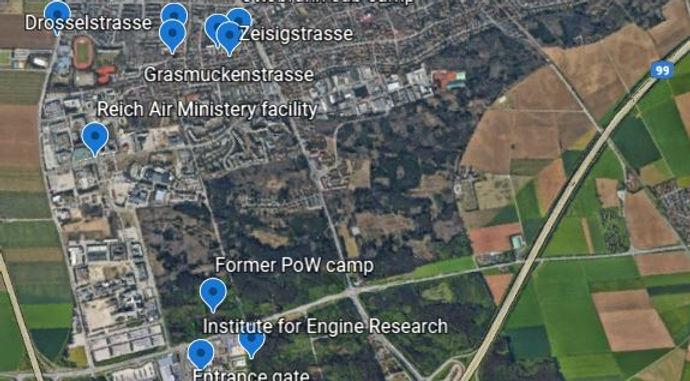
Ottobrun


Ottobrunn is, today, another suburb of Munich, located in the south east region of the city. However, during the Second World War, the location of this sub-camp was in the middle of a forest. The site of the camp is now residential housing, located on the Zeisigstrasse, southwest of the Rosenheimer Landstrasse. It was established in 1944. According to sculptor Wolfgang Sandt, the existence of this sub-camp was discovered by a youth group from the Protestant church in Ottobrunn in 1982, after many years of it being hushed up. The youth group publicly announced their discovery and brought the existence of the camp back into the mainstream public awareness.
1982 a youth group of the protestant church in Ottobrunn learned about the subcamp and brought the fact of its existence back to public consciousness.
The camp held about 400 prisoners who were employed on the construction of a test facility for the Reich Aviation Ministry. This was located on a site currently occupied by a sports park on the Haidgraben. The prisoners had to work 9-11 hours per day and were held in wooden barracks. They seem to have been treated fairly well compared to the conditions experienced in other concentration camps and this may have been because the camp was originally supposed to accommodate civilian workers. However, it seems that there were some reports of mistreatment and violence, with at least one death. On at least seven occasions, prisoners were punished by having to perform exhausting exercises with some incidences of flogging. The camp was evacuated on 1st May 1945, before the completion of the test facility, and the prisoners were briefly forced to undergo a 'death march' before finally being liberated by American troops.
Mr Sandt was informed by some of the older inhabitants of Ottobrunn that the reason the prisoners were treated relatively well is because the SS guards leased them out to local businesses. However, it also seems that the SS guards consisted partly of petty criminals who earned extra income from leasing the prisoners out.
In 1988, the 'Mahnmahlinitiative Ottobrunn' was founded in order to construct a memorial to the concentration camp inmates. Wolfgang Sandt designed a stone memorial for this purpose, but it was not erected at the site until after a long public discussion had been held on the matter, involving considerable political disagreement. However, the Ottobrunn community council finally agreed, on 22nd February 1992, to attach an information board to an older monument in the Friedenstrasse.
In 1996, a book was published with the title Forgotten? Repressed? Processed? written by Stefan Plochinger, discussing the camp and the history of Ottobrunn in the Nazi era. A copy of the book is held by the Ottobrunn Municipal Library.
Further information is available on a blog written by two Munich bloggers, Gitta and Helmut, including an interesting map (below) showing the location of the Ottobrun sub-camp in relation to the Reich Aviation Ministry facility. Gitta and Helmut state that the camp was surrounded by a barbed wire fence with 2000 to 3000 volts running through it, in order to prevent escape, and that there were between 500 and 600 prisoners in total. There were four barracks, two dormitories, a canteen barrack, a punishment block and a toilet block. In the middle of a courtyard, there was a fire pond measuring 6 square metres which was apparently also used for torturing prisoners. The punishment block consisted of very small chambers in which an iron bar was located in such a way as to prevent sitting.There was a watch tower on the western side of the camp where the Zeisigstrassed makes a 90 degree turn. This is also where the commandant's barrack was located along with bunkers for civilian staff. There were around 55 guards. A floral display was located in front of the command barracks, arranged in the shape of a swastika.
Workshops for the manufacture of specialised components were located west of Drosselstrasse. The buildings of the Reich Air Ministery facility (Aerodynamic Institute) were located south of the present Ottobrunner Sports Park on Haidgraben, which was constructed in 1969, and on the site of the current European Aeronautic Defense and Space Company that borders to the sports park to the south. It seems that the building housing the test facility - a wind tunnel - still exists.
In 2016, a storm tore out a number of trees in the nearby forest, north of the current Brunnthal industrial area. This led to the discovery of foundations from former barracks of a nearby prisoner of war (PoW) camp. This area was also where the warehouse for the construction team of the Institute for Engine Research was located.


